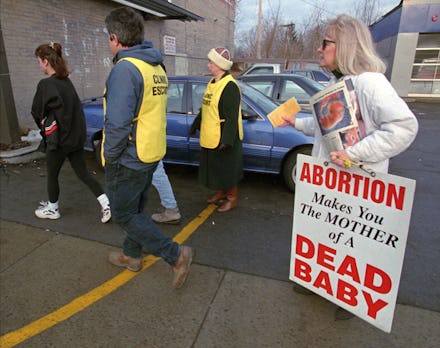If You Care About Women's Reproductive Rights, This Is the Case Of the Year

You cannot claim freedom of speech in order to better harass people, especially when no one is actually stifling what you say. This is the message anti-choice, abortion protesters across the country should understand, and hopefully one that the Supreme Court will uphold when it hears oral arguments in the case of McCullen v. Coakley on January 15.
The highest court in the land is expected to determine whether or not a Massachusetts law establishing a 35 foot buffer zone around reproductive health clinics infringes on protesters’ constitutional right to freedom of speech. The ruling will affect similar buffer zone ordinances in Oregon, Vermont, California, Maine, Colorado and Montana meant to protect patients from overzealous, anti-choice demonstrators. The ruling could also jeopardize buffer zones around polling places aimed to prevent voter intimidation. With this in mind, the Supreme Court should uphold the Massachusetts law.
1. Buffer zones serve a compelling interest
The buffer zone fulfills a reasonable need for safety and order around a contentious political issue. Aross the country between 2007 and 2012, there were eight reported arsons, 41 incidents of assault and battery, 37 bomb threats, 41 death threats, 81 suspicious packages, 50 reports of staff and patients being stalked, and 30 facility blockades that shut down clinic services between 2007-2012. In Massachusetts demonstrators physically blocked clinic doors, and routinely used violence and intimidated. To dissolve the buffer zone is to grant intrusive and sometimes completely insane demonstrators full, unsolicited access to clients and risk public safety. This is not worth anti-choice advocates desire to "intimately counsel" women when those women could easily walk 35 feet to receive that counseling.
2. Buffer zones do not unjustly burden protesters
Reasonable buffer zones do not put freedom of speech at stake. As CEO of Planned Parenthood League of Massachusetts and former state legislator Martha Walz flawlessly said, "Outside the buffer zone, protests can and do occur, so the law only regulates where people can stand, not what they can say." The 35 foot distance in Massachusetts translates to seven second walk to a clinic's front door. This is completely reasonable for protesters and consistent with time, place, and manner of free speech which allows reasonable restrictions on traditional public forums such as streets and sidewalks. Walz added, "Those 7 seconds of not being harassed on the way to the front door make a huge difference" for women.
3. Buffer zones strike a balance between free speech and the right to privacy
Freedom of speech is an extremely important right, but not an invitation for anything-goes behavior, especially when other rights hang in the balance. The 35 foot buffer zone strikes a fair balance between the first amendment guarantee of free speech and the federally protected right to privacy. A balance anti-choice advocates would expect if the roles were reversed; if pro-choice supporters bombarded anti-choice church doors, denounced their religion, harassed church patrons, and even made bomb threats. No doubt the conservative outrage machine would kick in full gear faster than you can say Pussy Riot. Just as demonstrators want and should exercise freedom of speech, clinic clients and staffs should have the right to be left alone at their facility doorways.
When the Supreme could decides McCullen v. Coakley one can hope for the best. Seriously, all women are asking for is at least seven seconds away from this: